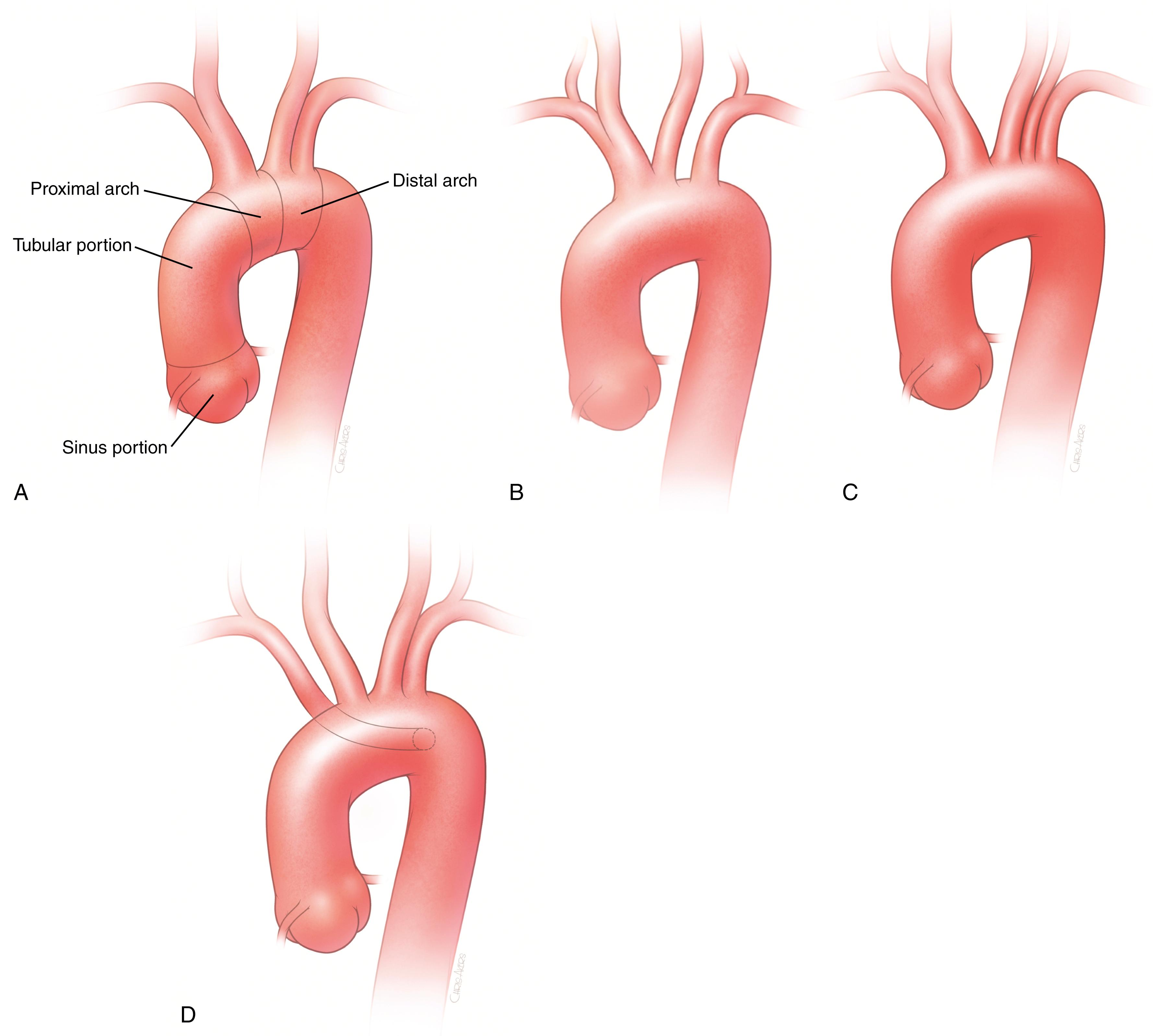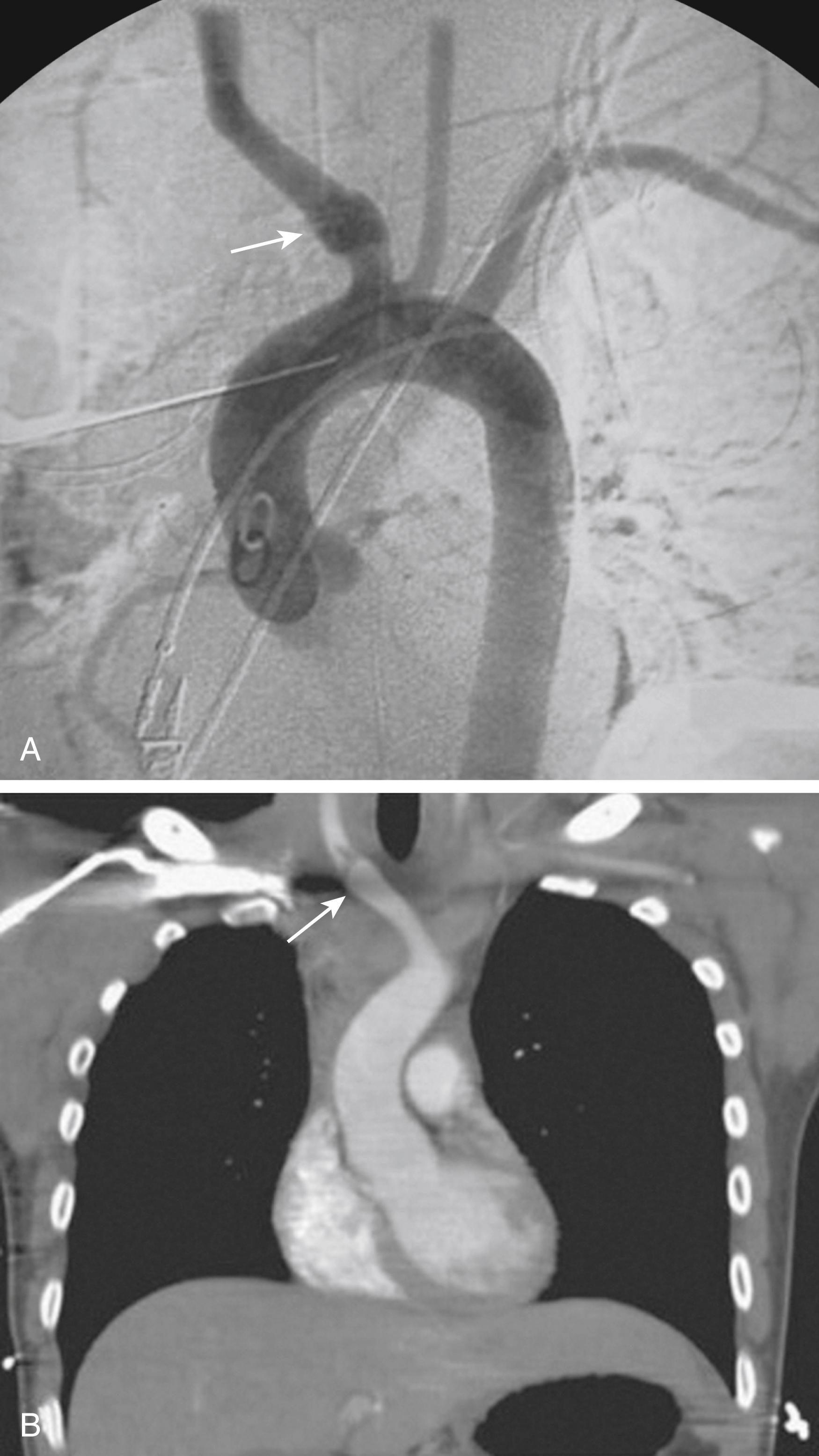Physical Address
304 North Cardinal St.
Dorchester Center, MA 02124
The brachiocephalic arteries constitute the aortic arch branches, including the innominate, left common carotid (LCCA), and left subclavian arteries (LSCA), also known as the supra-aortic trunks (SAT) or great vessels. SAT disease is predominantly atherosclerosis with steno-occlusive lesions. Aneurysms, arterial dissection, isolated or extending from the aortic arch, arteriopathies, radiation changes, and traumatic injury can occur. These may lead to upper extremity ischemia such as claudication or thromboembolism, and neurologic ischemia including stroke, transient ischemic attack, and vertebrobasilar subclavian steal. Neurologic symptoms may be related to thromboembolism, or, in the case of multi-vessel disease, global ischemia. In those with internal mammary coronary grafts, coronary steal may occur. Rarely, compressive or inflammatory symptoms such as hoarseness, dysphagia, dyspnea, or cough may develop. This chapter discusses open reconstruction for SAT disease.
The “normal” arch is a left-sided arch with distinct origins of the innominate artery, LCCA, and LSCA, present in 70%–75% ( Fig. 101.1 ). A c ommon shared origin of the innominate and LCCA, “bovine arch,” is the most common variant, seen in 21%–27% of individuals. The left vertebral artery originates directly from the arch in 3%–4% of individuals. An aberrant right subclavian artery (ARSA), originating posterior and distal to the LSCA, occurs in 0.8%–1% of the population. It is due to abnormal involution of the 4th aortic arch and persistence of right dorsal aorta fusing with the right 7th intersegmental artery, and is more common in women. , A variety of rare patterns constitute the remaining variants. Ethnic differences are reported with less variation in published series from Asia and the bovine pattern is more frequently seen in Africa and South America. , , Links between aortic arch pathology and anomalous brachiocephalic branching is suspected. Recognition of anatomic variants is important in assessing and treating patients with SAT disease.

When symptoms suggest SAT disease, comprehensive physical examination including carotid and upper extremity pulse assessment and bilateral arm pressures should be performed. Carotid duplex ultrasound may identify elevated velocity flow, parvus–tardus waveforms, reversal of vertebral flow, or concurrent carotid disease , (see Ch. 22 , Vascular Laboratory: Arterial Duplex Scanning). Upper extremity noninvasive studies including pulse volume recordings and segmental pressures help appreciate the degree of central flow reduction. Axial imaging is key to visualizing the aorta and SAT. CTA and MRA have replaced conventional aortography for diagnosis. , Aortography and selective arteriography are now largely utilized for endovascular intervention, but may still occasionally serve for disease definition. Body habitus, claustrophobia, metallic implants and renal disease limit or alter use of CTA and MRA. MRA signals drop out at slower flow rates, in areas of complex flow patterns, or with movement, overestimating stenosis. MR also allows for important brain imaging (see Ch. 30 , Magnetic Resonance Imaging and Arteriography). CTA is usually completed more rapidly but can be limited by dense lesion calcification, which is common. Vessel wall and lesion characteristics are better appreciated on CTA. It is particularly helpful in assessing ascending aortic and SAT quality for anatomic or extra-anatomic reconstruction suitability (see Ch. 29 , Computed Tomography). Transesophageal echocardiography (TEE) or intraoperative epi-aortic ultrasound may be of value in characterizing the aorta for clamping.
Atherosclerosis, although the most common SAT pathology, is infrequently encountered clinically, accounting for <9% of cerebrovascular lesions. Aortic arch branch vessels account for <5% of cerebrovascular operations. , The subclavian arteries develop significant disease more frequently than the innominate or LCCA. Hemodynamic patterns and shear stress changes in the arch predispose the SAT origins and proximal trunks to plaque development. , The LSCA is most frequently involved. Most patients with SAT atherosclerosis are in their early sixties, typically Caucasian, with extensive smoking histories, and multiple atherosclerosis risk factors. Approximately 20%–40% of patients have multi-vessel involvement. Trans-sternal repair is performed more often in patients with multi-vessel disease.
The most common form of non-atherosclerotic occlusive disease is giant cell arteritis (see Ch. 138 , Vasculitis and Other Uncommon Arteriopathies) and Takayasu disease (see Ch. 140 , Takayasu Arteritis). Both have acute inflammatory phases with systemic symptoms and vessel wall inflammation. In the chronic phase, fibrosis and tapering stenosis or occlusion develop. Takayasu arteritis more frequently involves SATs and is the etiology in 20% of patients requiring reconstruction in the western hemisphere, with the majority having multi-vessel disease. Takayasu arteritis predominantly affects females in their 20s and 30s. The highest incidence is in the Far East and in individuals of eastern descent. Radiation-induced arteritis can lead to great vessel atherosclerosis and stenosis decades after treatment. ,
The decision point in SAT occlusive disease management is symptoms. Symptoms are neurologic in 50%–90% and upper extremity in 10%–40% of cases. Stroke, transient ischemic attack, hypoperfusion, embolism, or claudication may be seen and present in both territories in up to 40%. , , , Lesions can lead to subclavian steal syndromes. Subclavian–coronary steal causes angina with internal mammary coronary grafts. Subclavian–vertebral steal leads to vertebrobasilar symptoms and vertebral artery flow reversal. Asymptomatic lesions should generally be managed medically. Indications for reconstruction without symptoms include innominate and/or subclavian lesions proximal to hemodialysis access or peripheral bypasses, or severe disease proximal to prior or planned internal mammary coronary revascularization. It should also be considered to allow accurate blood pressure management in patients with intractable control and disease leading to erroneous monitoring. Finally, failure of endovascular therapy is an indication for open surgical SAT revascularization.
Blunt and penetrating SAT injury has a spectrum of severity ranging from minimal intimal injury, dissection, mural hematoma and pseudoaneurysm, to partial or complete transection with hemorrhage and extremis. Upper extremity ischemia, neurologic event, or compression of vital structures may be present. Pseudoaneurysm formation may present acutely or late. Blunt or penetrating SAT injury represents 3%–10% of arterial injuries. , Unlike the distal aortic arch, which is fixed to the posterior mediastinum leading to a higher likelihood of torsion and deceleration blunt injury, SAT are not tightly fixed and blunt injury is less common. Penetrating trauma is more common and may affect any SAT vessel ( Fig. 101.2 ). Assessment should be directed by examination and mechanism. Most patients with major blunt deceleration injuries or chest and thoracic inlet penetrating injuries who are not in extremis should undergo CTA (see Ch. 181 , Thoracic Vascular Trauma). Urgent repair of traumatic SAT injury is indicated for patients with hemorrhage, critical extremity ischemia, and compression of vital structures. If possible, resuscitation and correction of physiologic abnormalities should be accomplished prior to repair, particularly if open reconstruction is planned. Minor asymptomatic injuries can be medically managed with antithrombotic agents and monitored for resolution. Most clinically occult low-grade injuries remain stable or resolve. Stroke from blunt injuries most commonly occurs at the time of injury or soon afterward. Recurrent stroke is infrequent on medical management. In follow-up of medically managed SAT injuries, surgical repair should be directed to new symptom onset; recurrent thromboembolic events despite medical therapy; and enlarging or symptomatic pseudoaneurysms.

Dissection of SAT occurs spontaneously or as extension from the aortic arch. In patients with aortic dissection extension into the CCAs, 19% of patients present with stroke. Even with aortic repair, SAT dissection persists. Subclavian artery dissection can cause posterior circulation neurologic events, arm ischemia or myocardial infarction when internal mammary coronary grafts are present. Healing remodeling or anatomically stable dissection are the most common outcomes. Degeneration with aneurysm or thromboembolic events are rare. Spontaneous brachiocephalic dissection with subacute retrograde aortic extension has been described. Similar to cervical carotid dissection, initial medical management with antithrombotic agents for 3 to 6 months is the treatment of choice. A randomized trial demonstrating a low risk of recurrent stroke with anticoagulant or antiplatelet agents in carotid dissection has led to similar practice for brachiocephalic dissection. Patients with initial rupture and hemorrhage, pseudoaneurysm, associated mobile thrombus, or early rapid enlargement should be repaired. Enlarging aneurysm, recurrent thromboembolic events, or persistent/progressive severe carotid stenosis are late indications for repair.
True, isolated, proximal brachiocephalic artery aneurysms are rare, most frequently occurring in the subclavian artery and less frequently in the innominate and LCCA. , They usually occur in continuation with adjoining aortic arch aneurysms, or may be related to arterial thoracic outlet syndrome (see Ch. 125 , Thoracic Outlet Syndrome: Arterial). Patients younger than 50 years should be screened for genetic disorders, such as Loeys–Dietz and Marfan syndromes. A painless pulsatile mass may be palpated or seen. Symptoms include chest, arm, upper back or neck pains, upper extremity and neurologic thromboembolization, hemodynamic vertebrobasilar events, compressive symptoms such as dyspnea, dysphonia, dysphagia, cough, cervical radiculopathy/brachial plexopathy, and hemoptysis or hematemesis due to aerodigestive erosion. Symptomatic thromboembolization is the most frequent presenting symptom. Thrombosis of subclavian aneurysms as small as 2 cm has been reported. Symptomatic aneurysms should be repaired. Isolated brachiocephalic aneurysms may be identified incidentally on axial imaging, and this is how most are now identified. These patients are usually asymptomatic with small aneurysms (<3 cm) and the natural history is slow growth and rare complications. It has been recommended that smaller, asymptomatic aneurysms be repaired due to the concern for thromboembolism. However, based on recent data, surveillance in asymptomatic individuals, with selective repair in those with thrombus burden or growth may be considered. Open repair is associated with significant mortality and morbidity. Kieffer and colleagues reported 11% perioperative mortality after open repair of innominate aneurysm, but included ruptured and infected cases with most associated with arch aneurysm. Bower et al. reported a 30-day mortality of 8.2%, with all deaths occurring in urgent/emergent cases. Interestingly, late survival was worse in those with innominate aneurysms. Unfortunately, it is uncommon for the anatomy to be suitable for isolated brachiocephalic endovascular repair, although it may be an option in select cases (see Ch. 102 , Brachiocephalic Artery Disease: Endovascular Management). Proximal occlusion with cervical surgical revascularization may be appropriate in cases when traditional resection and revascularization is technically challenging. Aortic endovascular grafts may provide this proximal occlusion ( Fig. 101.3 ). This is an important consideration in treatment of ARSA aneurysms. Tissue of the persistent 4th aortic arch and the 7th intersegmental artery in this anomaly is prone to degeneration and aneurysm, called Kommerell diverticulum. This may be associated with aortic aneurysms. A normal caliber ARSA causing compressive symptoms, or a degenerative ARSA aneurysm should be repaired. Options include traditional open aortic reconstruction and right subclavian artery (RSCA) revascularization, right subclavian revascularization and ligation with thoracic endovascular aortic graft exclusion (TEVAR), and total endovascular repair using TEVAR and periscope right subclavian endograft. , Thoracic aortic aneurysms or dissections, even without SAT disease, are a current indication for SAT revascularization (arch debranching) to permit more proximal endograft seal zone (see Ch. 80 , Thoracic Aortic Aneurysms: Endovascular Treatment).

Become a Clinical Tree membership for Full access and enjoy Unlimited articles
If you are a member. Log in here